The Great CitiBike Midtown Hollowing Out

The great early CitiBike rage-out appears to have largely subsided by now. Besides the obvious angry sorts (people who hate parking spaces disappearing, people who hate being run down by Euros on enormous bikes, and people who hate watching tourists grapple with difficult instructions), one man suggests: people were angry because it’s basically cheating. There is a truth to this, as you know if you have wheeled your way to a meeting on-time that a cab and the seemingly often summer-busted subway would have made you late for!
Really the great CitiBike experiment has been… so-so. The software sucks, the machinery is hateful, the “real” bikers hate you because they assume you don’t know how to bike, and don’t forget the tickets — and then there’s the Great Midtown Hollowing Out. Each day, there are some overall trending movements. The tourists are noise in the system of the signal of commuters and resident users. Certainly, by end of the day, bikes disappear from the center of Manhattan toward the edges. And then you are left with empty forlorn sweaty racks, as the picture in Herald Square yesterday evening shows. And where are the bikes now? They are uptown and downtown — but also they have migrated inward for the afternoon. Later, the map will hollow out again.
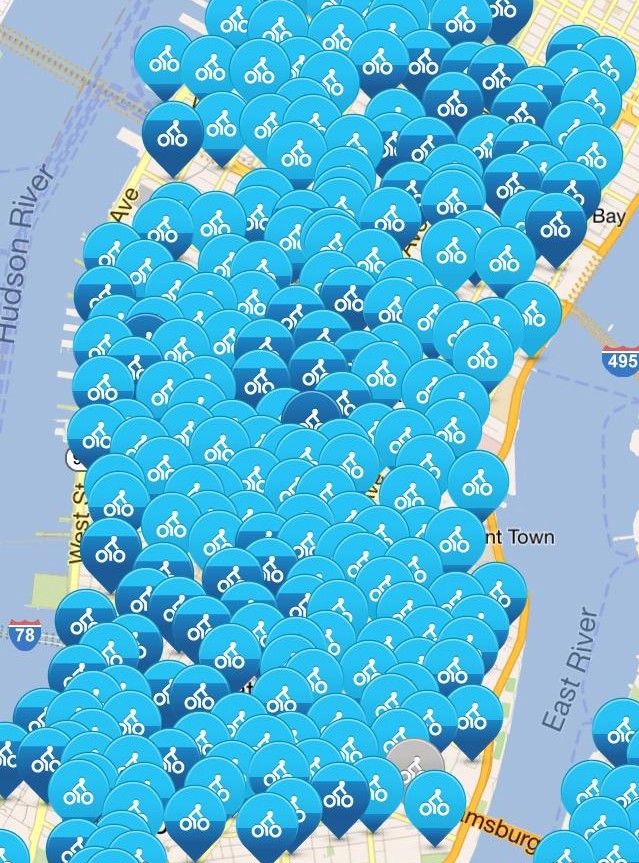
Penguin Randomly Mucking With Vikram Seth

Vikram Seth’s agent appears to be publicly litigating his book deal with Hamish Hamilton, an imprint of Penguin, an arm of Penguin Random House, a co-owned subsidiary of Bertelsmann and Pearson plc. (That’s just fun to type.) According to the Mumbai Mirror, the hybrid publishing monster asked for their $1.7 million advance back. Seth’s publication date was supposed to take place in 2013, and he has apparently not delivered A Suitable Girl, his poorly named sequel to A Suitable Boy, which came out TWENTY. YEARS. AGO. (How crazy is that.) Why? And how? What a fishy story. It’s impossible to believe that any publisher won’t just sit out the wait for the manuscript, particularly at a company that grosses more money than Antigua and Barbuda.
Savage Night At The Opera
A reading, an opera, a live musical show and another thing. Warning: they will blindfold you at Lera Auerbach’s opera! Because it is about being blind. Except it’s a “metaphor.” Which led one writer to talk about the opera as a place where “oppression is reduced to aesthetics.” (That’s not a good thing.)
The Pines Pavilion
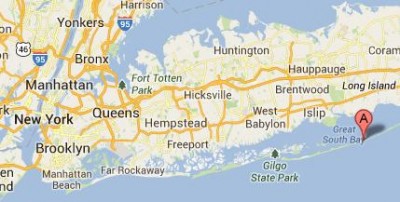
Matthias Hollwich and Marc Kushner are the cofounders of HWKN. Their just-completed (barely completed!) project is the third incarnation of the Pavilion, which is the primary dance hall and bar of the gay community of Fire Island Pines. When proposed images of the building were first floated on the Internet, no one believed that the building would come to pass. Now the building, as envisioned, has a temporary certificate of occupancy, and has been open for the last two weeks. Permanent exterior railings will be installed shortly.
The Pavilion consists of a small ground floor, a large open upstairs deck, and an interior dance hall. The dance hall is a long room that shrinks at the corners, ascending with bleachers on each side, one with a discreet window, one with a large viewing window. Here it is all decked out in tacky 4th of July bunting.

How has the feedback been so far in the initial weeks?
Marc: Feedback started a long time ago. The minute it burned down — is it going to be up by next season? Everyone is so invested. Social media really facilitated this discourse.
Matthias: I think what was interesting was there were like moments when the first sketches were published — we were really scared. There was first disbelief: This will never happen! Others were like, “who’s still going to have long hair in 2013?” That was our harshest critique. Then when it got built, people were just totally in awe. Everyone confirms that it really hit the wants and desires of the community. People feel like it’s social, it’s inviting, it’s empowering. But everyone really recognizes that this is a new period for the Pines, where the level of architectural sophistication has been reintroduced after a period of banality. Gifford1 did this in the private space; this has been introduced in the public space. I have not gotten one critique, period.
1 Horace Gifford was an architect active largely in the 1960s; the majority of his residences were built in the Pines. An excellent new book documents his life and work.
Marc: I heard one. One person said everyone he knew wanted to hate the building. It’s new, it’s big… and it’s a very vocal community with a lot of opinions. But despite that, they didn’t hate that. They couldn’t hate it. What we tried to do as architects is create something that worked really hard to please the community. We created a building that looks like it’s trying to please everyone. It wants to welcome everyone in off the ferry. t’s about the performance of the community.
Matthias: And it facilitates what they like to do. One, they want to have a good time, drink and socialize. And they also want to meet new people and look better and feel better. And that’s all what the building’s doing. Everyone loves the bartenders, and how we designed the bars, they’re in triangles. The bar guy is in the crowd, and we reduced the size of the bar. Even the bar guys said: Finally we feel like we’re part of the party! It’s about breaking down barriers. Making the space social on the inside.
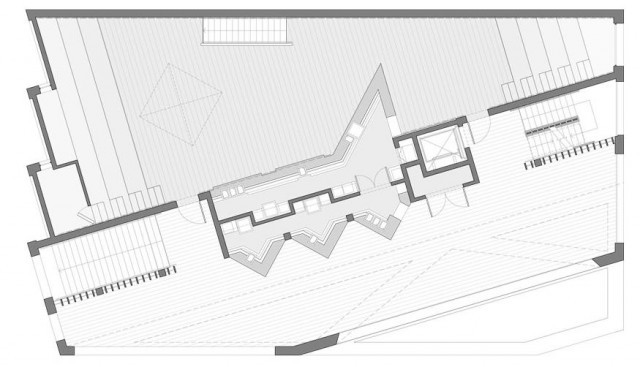
Mmm hmm, also when you zig-zag the bar, you get more linear bar space.
Marc: A happy byproduct!
You’ve described the original pavilion, built circa 1985, as a space with open circulation. The interior dance space has three exits, but only one is allowed to be used as an entrance. There are security guards. It’s a little stifling, and I want it to relent.
Matthias: Basically in an ideal word, people will open all the doors. People will circulate between inside and outside. But there are sound restrictions and mostly people are channeled. But the building is there to facilitate any kind of movement. And they can decide later, they can allow people from the welcome bar, the back. The architecture is offering. One additional point was that in the old Pavilion, one of the means of circulation was from the balcony walking down. But we couldn’t have balconies, so we created the bleachers. And I experienced that people circulate all the time inside. It never gets boring. People say, I’ve been there for five hours and I’m not bored. That’s a success. You have a limited amount of people on the island that go out and you want to satisfy them. So they energize the party.
You built out an aggressive bar front inside the club, which separates the main dance floor. Were you nervous about that? Did you fight about it?
Matthias: The key thing about a successful club we found out in research is you have to deal with different scales of people. The first ten who arrive need to feel comfortable. With this bar, people get stuck at the bar, they buy the first drink , and they look at each other and they’re comfortable, they create a crowd. Later you have 500 people in the club — and then the bar is in the way. But it’s also really important that Fire Island is not just Fourth of July weekend. It also needs to work on September 15th on a Thursday, for the commercial success of the buildings.
What was your least favorite concession? Was there something you really wanted to do that you couldn’t?
Matthias: Actually it’s banal. The stair down to the bathroom. If you could have pushed that stair outdoors or away — but there was no chance. We went through a hundred iterations. It’s an emergency exit. We softened it so it disappears, but I was hoping we could get rid of it.
Marc: For me, one of the biggest constraints — I think the solution we came up with makes the building better. But from when the building burned down, FEMA revised its flood tables.
Matthias: It’s like 11 feet from the water level.
Marc: Now all of a sudden we have this kind of plinth that the building rests on. It was tough. Now that lattice in front of the building, it creates this blur of inside and outside and it touches down and creates this bench. And the building changes scales that way. We made lemonade out of lemons. It’s not something we would have purposely done, raising the building that high.
Oh it works! It creates a shady spot to sit.
Matthias: The other things also — it’s the grid here, when you see it. You see this kind of gap in between, and this grid goes above the roofline. When high tea is active, it’s from 7 o’clock to 10, and the sun goes down on the other side. And it hits this beam and the light goes into high tea. There is light and sun in this space, just by the geometry. It makes it so much more comfortable.
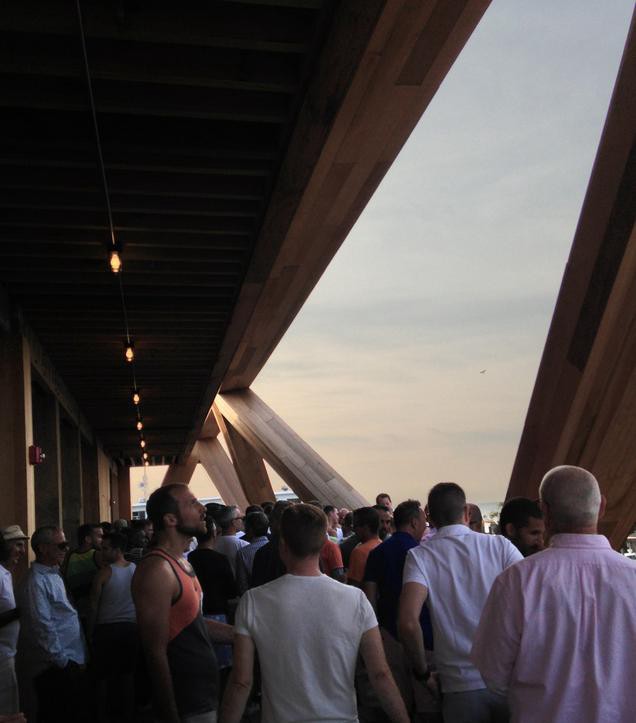
Did you consider other materials than wood, since the buildings of Fire Island are so infamously combustible?
Matthias: No.
Marc: No.
Do you think this is a gay building?
Marc: We think it’s a masculine building. There’s something —
Matthias: Very attractive for homosexuals.
Marc: I don’t want to get in trouble. But masculine, right? It’s, first of all, it’s rough. The materials are rough and the finishes are rough. We purposely exposed things architects do somersaults to hide: the conduits, the sprinklers. These are heavy pieces of infrastructure. And we didn’t want drywall. Instead of having drywall that’ll look like shit in a few years, we made it all out of wood. It’ll weather over time. There’s something attractive and I think kind of masculine, like the way Paul Newman’s face became more and more attractive as he weathered.
Matthias: I think it’s also, the kind of masculine attributes, it really attracts people to go there. We hear that people just love to check it out.
Have you seen the sun come up in it yet?
Matthias: Oh no, no, not yet.
2 This is a joke. They did no such thing.
Marc: Someone said the moonrise lines up perfectly. You could look up towards Long Island and it lines up perfectly. Of course we did that on purpose, we’re always checking lunar charts.2 Any architecture project you work on for a long time, and this was a compressed designing and construction period, once you launch it and users take ownership of it, you discover things you didn’t expect.
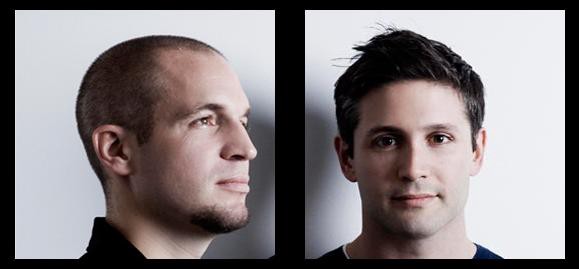
Left: Hollwich. Right: Kushner.
The HVAC inside is spectacular. Was that something you wanted?
Matthias: We do have a full-fledged air conditioner unit up there which you can boost amazing cold air in there if you want to, but it’s for operational purposes now, for the team, who decided after the first night that they had it fully on and never anyone broke a sweat. Now they turn it lower, so people drop their shirts. And you can open the skylight and the sound levels aren’t excessively high. So you can open the skylight and cool it off on a cool night.
The sound is designed in such a way that inside, you can hear people talk!
Marc: Because of the wood, it’s like a concert hall, without the sound reverberating off concrete walls. This was what Matthias did an amazing job of. Usually in a nightclub the lights and sound system are design afterthoughts. Crews come in and put stuff where they want. Matthias was there twice a week, screaming and yelling. Those elements don’t just create sound, they’re part of the space. And the placement of the lights, the integration of the lights into the wood cladding, became a very big thing that we tried to include.
Matthias: From our other experience designing events, our first thought was where do the the lights go and how do we enhance the architecture. It’s a very purposeful design.

I haven’t heard you talk elsewhere about the gym on the ground floor, which is glassed-in. Which I personally hate, but I think that people probably love? It’s a display box!
Matthias: When you think about it like that, I would like to make it more so. They have equipped it with some of the equipment they have, but there’s nothing cooler than you come to the ferry and you look and you see guys sweating and working out. We would have liked to open maybe the windows, but for whatever reasons that didn’t happen. I always loved the outdoor gym on Fire Island, and I will miss it.
There’s a thing about posing and displaying and narcissism that is good for the Pines but sometimes goes too far.
Marc: Well it touches on all those things. There is a point when the architect has to let go. If they buy a shitty clock and hang it on the wall, well then.
Matthias: Um.
Marc: There’s definitely a culture on Fire Island that’s about awesome bodies and it’s kind of a nice moment, and there’s nothing to be ashamed of that that’s part of the culture.
Matthias: There’s a program there and it’s called retail. It works and the gym is something I appreciate much more than probably any other program they could move in there. There’s a little more curation needed for the location of the machines.
How would you describe the process of building in the town of Brookhaven?
Matthias: Good! I think after the big hurdle was taken, in the first hearing, which obviously it’s a public hearing, so there can be a lot of opposition. And it’s 50% overbuilt based on the site plan legally. But because it burned down, it was grandfathered in. And we had to comply with all kinds of requirements. They were hand in hand with us and super supportive, up until the last bits, for the temporary c. of o., which is based on the goodwill and their beliefs that you run the building correctly. They were great.
It could have not happened.
Marc: The impression I got was that they understood you were trying to build something special. That almost changes the conversation with towns. When you go and show that you’re making something public and for the community, it changes the dialogue.
Matthias: And you need to make the right bathrooms and be ADA-compliant and it needs to be fire safe. I hope we achieved above and beyond the one opposition we had from ecological groups, who fight very hard for the national seashore, which I think is a great fight. What we took away from the meeting was what we wanted the building to be. We wanted it to be 50% outdoors pace, which limits the impact on the environment. We used all wood, which is recyclable and biodegradable. Even without fancy LEED certification or anything, we pushed as far as we can to very close to what ecological groups would want.
Well and we all know LEED is basically bullshit. Green certification now is like, people getting new “green doors” and throwing away their old doors in some landfill. What else! Tell me about the bathroom sinks. Do you think people will pee in them?

Marc: Matthias made a full scale mockup in the office out of foamcore.
3Sip and Twirl is the bar/complex next door. It had a remodel recently, which definitely made some improvements. One advantage of Sip and Twirl however is that it plays exceptional house-oriented music in the evenings, instead of that coked-up high-BPM bullshit that’s so popular now. Sorry! But that banging pots and pans Adderall-friendly music now is garbage. It should go without saying that this is solely my opinion, not that of the architects being interviewed.
Matthias: The requirements were gigantic. You see how many stalls there are, it’s required by law. And it complies with a mall topology. So with that we can have all the bathrooms central in one location. If you look at Sip and Twirl3, there’s one for the dance floor, there’s one for the bar, one in the restaurant, it’s horrible, it really disrupts the program. So we packaged it. But every program needs direct ADA access.
Marc: So all roads lead to the bathroom.

New York City, July 7, 2013

★★ Contrails stuck to the otherwise empty morning sky, each in a different stage of diffusion. The heat was solid and indisputable, the streets eerily vacant. A pack of bicycle-borne billboards sat idle, advertising vitamins to nobody. One might have been the denizen of some ghost city, if not for the drops of sunscreen-laced sweat rolling over the upper lip. Cumulus clouds gathered in the afternoon, then went away again. After dinner, out on Pier I, a band sat in the shade of a temporary stage with a pitcher of ice water. The trombonist and mandolin player were barefoot. The Hudson heaved gently; a cormorant, riding low on the water, took flight. The toddler stopped and stared at an immense pit bull that lay in the middle of the pier, placidly destroying a water bottle with its heavy pink jaws, and then he burst out crying. “Wa-wa!” he wailed, eventually, through his tears: he was thirsty. Far off to the south was a single great curving vertical mass of cumulus, a scoop catching the pink light. By the time the older boy was out of the bath, a flat blue pile of cloud had appeared over New Jersey. One crisp white grease-pencil rendering of a lightning bolt appeared against it, and then came flashes and flickers inside the cloud, fleeting moments of three-dimensionality. The dark blue spread east like ink in water till its progress was lost in the twilight. The building creaked in a gust of wind. And then nothing happened at all.
New York City, July 4, 2013
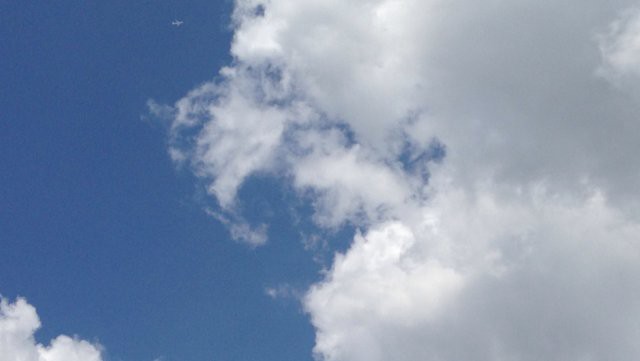
★★★ Oversized cumulus clouds stretched from the towers on the west to the towers on the east, being picturesque and cutting off the light. When the sun was out, it stabbed at the nape of the neck. The sidewalks were reasonably well occupied, and the air was not as soggy as it had been. Old people’s knees and young people’s shoulders were on display. A piece of orange peel baked dry on a sidewalk grate. Another piece, possibly finishing the peel of the same orange, baked on the sidewalk a few steps on. Men had made some incorrect decisions about which of their undershirts could be passed off as clothing. Around the back of the building, in the garden, the immense lobby welcome mat was slung over some long, low garden feature to air out, recovering from the week of rain. In the cloud shadow, the wind was mildly exhilarating. By dinnertime, the sky had cleared out, save for a few pretty pink-and-gray clouds decorating the west. The air was clean and hot, and the lowering sun haloed the heads of citizens walking west to the river. A fledgeling grackle, soft pale down tufting out here and there, fluttered to climb the chain-link fence overlooking Riverside Park South, then dropped back down, chattering at passersby. It eventually got through the fence and crouched in a hollow, still chattering. An adult grackle came by, briefly, and studied the scene. The tall bank down to the river was frosted with clover blossoms. Above the edge of the elevated Joe DiMaggio Highway, the dark familiar shapes of police officers’ caps poked up against the lovely late blue.
Meet The Awl 2013 Interns
Each year, young people come and do some things here! And each year, we worry that they will sue us. But no: they will not. The intern’s job isn’t fetching coffee or proof-reading; they’re here to write about stuff and have a good time. (And yes, lawyers and judges, they set their own hours, do no office work or work that would otherwise be created by employees: they come and go as they wish, and are in charge of their destinies.) They’re just now getting into the swing of things and filing stories, so we figured we should be courteous and let you know who they are. So far, I can tell you that they’re all delightful and hilarious. You will be working for them someday soon. And, if I’m nice this summer, so will I, so, booyah. This year’s weird coincidence: two Yales, two Kenyons! What are the odds? (Actually the odds are pretty good.) In alphabetical order, the Awl Summer Reporter 2013 team! If you see them out and about, say hi.

Resita Cox is a sophomore at the University of North Carolina at Chapel Hill. She is studying Journalism with a concentration in electronic communication, and a double major in Political Science. She has written for The Daily Tar Heel on campus and currently writes for Natura Magazine, a hair and health magazine. She was named North Carolina’s 2012 Journalist of the Year during her senior year in high school and was editor of her high school newspaper. She spends her free time writing poetry, blogging, stalking music blogs and famous people, and trying to be a sane writer (although we all know that is not possible). She is 30% words and poetry, 20% overly sweetened coffee, 10% fortune cookies and 40% hip-hop and all things music. She loves to chat; in fact, it is one of her favorite things to do so feel free to email her your comments, thoughts or suggestions at rhcox [AT] live.unc.edu. You can also visit her blog.

Becca Hafter attends Kenyon College where she keeps a Google doc of party themes with her roommates. She’s pulling for a “mystic spa/enchanted lagoon” party in the fall. Sometimes she writes highly conceptual news stories for the Kenyon Thrill, which she also edits.
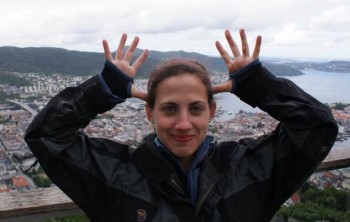
Sarah Jampel didn’t ask to be born and raised in Baltimore, but so she was. Now, she’s getting her BA in the even less nice city of New Haven. At Yale, she’s on a mission to find out the precise combination of fluorescent lighting, lack of sleep, and hypothermia from chilled library air that will lead to a perfectly pasty complexion. This is her first summer in New York, where she is also an intern at Food52. So far, she’s seen 3 roaches (2 alive, 1 dead) and 4 rats this summer.

Carmen Johns is a rising senior at Oberlin College where she majors in French and teaches ceramics.
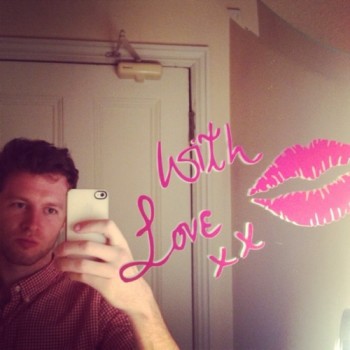
Brendan O’Connor graduated from Kenyon College in 2012 with a degree in English and a sense of purpose. Great with children and grandmothers, he enjoys cocktail parties and stirring up trouble. He knows the drunk tweeting is a problem and promises to work on it.
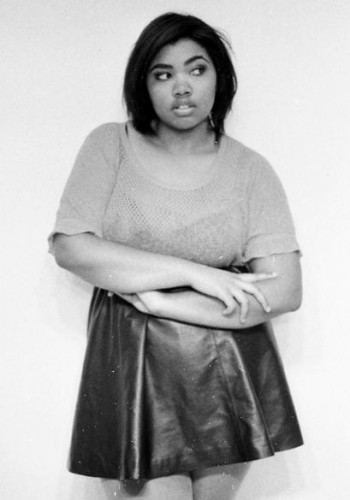
Hadiya Shire is out to demolish the Midwestern ideal, but don’t count this Minnesota girl an expatriate; she’s merely on loan indefinitely to our abundantly fertilized “Big Apple.” As a senior at Vassar and editor of its Art and Style magazine Contrast, Hadiya explores her interests in English Literature, Art History and Media Studies. She is currently learning the Arabic language and perpetually reevaluating the status of her ever-evolving cultural identity. Her hobbies include contemplating the practices of comedic geniuses, and the likes of those who may follow in their footsteps — all the while hunting for the cheapest pack of American Spirits.
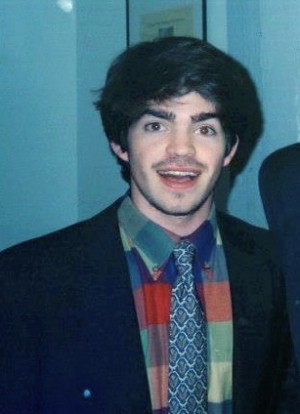
John Stillman has appointed himself Editor of the Dept. of The Forgotten Borough. He is a senior-to-be at Yale, where he is an editor at the Yale Herald. He also runs the Bullblog, your home for breaking news like “Chipotle Coming to New Haven” and “Owl Spotted Outside Lecture Hall.” He’s living in Brooklyn and working on Staten Island this summer, and would love your company on the 80-minute walk-train-bus-walk one of these mornings. Alternatively, you can follow him on Tumblr and find him on Instagram @straitflexn.
"Bet Raise Fold": How To Make A Modern Poker Doc
by John Shankman
The documentary Bet Raise Fold tells the story of three online poker players, the companies who make online poker possible, and online poker’s Black Friday — the day in 2011 that the government seized the domains and froze the bank accounts of three of the largest online poker operations.
The movie’s genesis is wholly of the modern day too. This is an independently produced and distributed documentary, funded by a group of 12 online poker players. No big studios were involved. The production spanned three years. Distribution is being supported by direct-to-consumer distribution platform VHX. A Kickstarter campaign provided the funds for music licensing, paying graphics people and sound editors, and starting publicity for the film. The Kickstarter raised $49,210, more than double its goal.
In the spirit of trying to discover and learn more about media disruptions that don’t include Zach Braff, we spoke with the producers and the editor and director of the film about the documentary’s challenges, stories and characters, about online poker — and about how one of them took home half a million dollars in under five hours back in 2007.
Here’s who we spoke to.
Jay Rosenkrantz: Jay is the co-producer of the film and has been playing online poker successfully since 2003. Jay studied film in college and has been working at the intersection of producing media and poker ever since. He writes The Micros, starred in the reality show 2 Months $2 Million and is a founder of one of the two major poker training websites, DeucesCracked. (Jay and I are friends and went to college together; I have no financial interest in Bet Raise Fold.)
Taylor Caby: Also a successful online poker player, Taylor is the Executive Producer of Bet Raise Fold. He is the founder of the other major poker training website, CardRunners. Taylor joined the project in 2009 because they figured a collaboration between two friendly poker rivals would be an undeniably validated production with an all-access pass to the poker world.
Ryan Firpo: Ryan, an independent filmmaker and owner of 918 Films, is the director and editor of the film. He met Jay in the famous online poker forum TwoPlusTwo.com in 2006 or 2007.

What was the hardest thing about producing this movie?
Ryan: Taming the story. It just kept unfolding and expanding and we quickly accumulated over 350 hours of footage. Trying to carve a 100-minute narrative out of that was the most challenging thing I’ve ever done, professionally. The film underwent radical changes throughout the process. The biggest issue was trying to marry the industry story — this epic, sweeping story that spans 10+ years — with the character stories, which were smaller, more contained and more intimate. For a long time those two stories felt like two different movies and my biggest challenge was trying to find a way to make them one.
Jay: One of the hardest things for me was making all the cuts. Deciding what to keep and what to omit… leaving the Ultimate Bet Scandal behind was tough. Not being able to spend more time with Martin. Not getting to tell some of the all time epic online poker stories, like Tom Dwan’s $5k shark tank prop bet or the Legend of Isildur1.
We had four different cuts of the movie: this one is the fourth. There were so many ways to tell the online poker story from the footage we had shot. It took us a long time to realize that capturing the personal impact of Black Friday was the most important goal. Black Friday destroyed our industry and I believe we needed to have something that could help us heal. As a community we needed to express what happened to us to other people. It was challenging to figure out how to adjust in the middle of shooting a story that did not account for Black Friday, but I’m proud of how we handled it. Playing high stakes poker was great preparation — as Tony says in the movie, poker teaches you to evaluate on the fly.
Do you have any experience with what producing and distributing a movie used to be like before the Internet? How is today different? Is it more rewarding today? Do you think the movie would have ended up differently if you had went the 20th-century route? Would this movie even have gotten made if this was two or three decades ago (ignoring the fact that two or three decades ago the Internet and online poker didn’t even really exist)?
Ryan: I started making films as a career around 2000, and YouTube was barely a “thing” back then [Editor’s note: It wasn’t a thing! YouTube didn’t come to exist 2005]. The Internet was completely different than it is today. Back then, to me, selling a movie to a distributor and building a rocket ship to the moon seemed equally plausible. I just had no clue how you could ever possibly get a company with reach to buy your film. I wouldn’t even know where to start. Now, you can conceive the movie, fund the movie, create the movie, edit the movie and even sell the movie entirely through the Internet. Jay and I never would have met without the Internet. I never would have discovered our characters without the Internet. I’ve still never even met (in person) a lot of important collaborators who worked on the post-production process because we worked entirely through the Internet. To be able to use this same tool to make direct contact with your audience and sell them downloads online is amazing. If you can find an audience, you can use the Internet to do basically everything you need to do to produce and sell a movie. This is totally different than when I started. I love the Internet.
Ryan: If we would have gone to studios now or 20 years ago and pitched a movie like this, there’s no chance it would have been funded. Online poker is a niche industry and a niche community. No chance a studio or film investor would see the potential profits in a movie about such a small world. Studios don’t make projects to connect to a small audience. They don’t see the point. Since everyone was connected — the investors, the filmmakers, the audience, the characters — through this online community, everyone just “got it” right away, and we raised the financing pretty quickly, and are currently doing well with our release so far — all Internet driven.
Jay: I studied film and television at Boston University before I became an online poker pro. I learned a lot about independent film distribution while I was there, but when I became an online poker player I learned even more about the Internet. Ryan and I produced several short films for the Internet poker audience, I write an animated poker comedy on YouTube, Taylor and I produce Internet poker training videos for a large audience of poker players. There’s so much freedom on the Internet, and if you can figure out how to reach audiences directly and get them rallying behind what you’re doing… I feel like there’s nothing more rewarding. We have been able to build the BET RAISE FOLD audience around us and utilize social media, platforms like Kickstarter to talk directly to fans who are passionate about what we’re doing. Now we’re harnessing disruptors like VHX and Tugg to distribute the film in a way that I think 21st-century audiences are really open to and excited about. What do all the middlemen do for you, what do the industry machines do for you except provide you reach at the expense of your bank account and the quality of your story? I am generalizing, but this is the mentality we have, the mentality that an entire generation of young artists has now. We grew up on the Internet, we know how to tap into its power, so we’re going to do that, have fun and figure out how to make the economics of it work.
How was the production of this movie financed?
Jay: Production was completely financed by a small group (~12) of online poker professionals. Many of them are considered to be some of the best players in the world, and all became independently wealthy through poker. We all lived the story we tell in BET RAISE FOLD. We wanted to make a documentary about the evolution of poker and people like us who played professionally on the Internet. We wrote a business plan and Taylor and I pitched it to a bunch of high stakes poker playing peers. We told them that independent film was a risky business and if they invested they should mentally kiss their money goodbye. Nearly everyone we asked pitched in. Everyone was willing to gamble on the idea.
What was your experience with Kickstarter? What will those funds be used for since the actual production was already accounted for?
Ryan: Jay can expand on the experience with Kickstarter. He spearheaded that entire campaign. I was pretty blown away by its success. Jay and I actually made a couple of over/under bets (i.e. betting how much the campaign will earn) throughout the process and I lost both of them. Now I owe him two dinners.
Jay: I felt bad taking Ryan’s money… he worked so hard for it! About one month ago, we launched a Kickstarter to power distribution efforts and complete finishing costs. It was an incredible experience. We sold $49k in preorders in one month, 2.5x-ing our initial $20k goal. The outpouring of support for BET RAISE FOLD from our friends, family and peers in the poker world was overwhelming. Kickstarter was an amazing platform for us to prepare the world for our online release, expand our messaging and bring our fans closer to the process of sharing the story. Everyone loved the ability to preorder in order to get their name in the end credits and be a piece of part of poker’s history. Kickstarter didn’t even exist when this project was conceived, but if we had started it today we would have tried to incorporate it from the very beginning. I think it’s just an incredible opportunity for fans to become part of a creative process in a way that’s much more personal than what was previously possible.
One challenge we have had to deal with is in educating people on what Kickstarter is and how it’s being used, why we’re using it. Audiences still aren’t used to the idea of a movie being online, having a “Kickstarter,” releasing on the Internet for $9.99… we’ve had to do a lot of teaching and communicating about what these platforms are and why they are cool. It’s been a great learning experience for us overall.
The movie has been out for a week now. How big of a success has the movie been from a “box office” perspective?
Jay: In terms of sales success, we really didn’t know what to expect. None of us have ever sold a full length movie before, and not too many people have ever sold a feature film like this before on the Internet. That said, the sales were among the highest VHX has ever seen for an “opening weekend” — we’re off to a good start.
We’ve got a worldwide audience watching (US, UK, Canada, Denmark and Sweden are leading the way). Twitter has unexpectedly become one of the major referral sources and word of mouth is overwhelmingly positive. It’s a bit too soon for us to share our data publicly, but it would be cool to release our results further down the line. We’re excited to have a free public screening sponsored by the World Series of Poker during their Main Event on July 9, as well as an early August release of subtitles for the film in 13 languages. We’re feeling great about how our strategy is working so far and are optimistic about where it’s leading us.

The movie supports and dispels some of poker and online poker’s biggest stereotypes; was this a goal of the film?
Ryan: The only real goal I had as the filmmaker was to tell a good story. As far as dispelling stereotypes: it’s hard for me to say, because I’ve been involved with this world for so long, it’s difficult to determine how “outsiders” view these online poker players (i.e. what kind of stereotypes they place on them). All three of our characters represent different shades of the online poker community, but for me these kinds of characters are pretty typical. I guess they almost seem stereotypical to me in a way… That said, I’m definitely aware people outside poker seldom consider the idea that you could actually support a family with it. We deliberately chose someone (Danielle) to prove it’s possible, and hopefully re-shape the way some people think about “online poker players.”
I feel like Danielle’s story is pretty progressive for the poker world. Do you feel like this? Is she an outlier as a female? Is online poker generally friendly to women? Is gender handled differently in online poker verse regular poker? I feel like given the masked nature of online play, it’s a pretty gender neutral sport/activity, is this true? Are the majority of online poker players male? If so, why do you think that is?
Ryan: Danielle is most definitely an outlier. The online poker community is pretty small, so most people are pretty well known — especially those who play the higher stakes. When I found out Danielle was 1) female 2) married with a three-year-old son 3) a high-stakes regular with an extremely impressive win-rate, it just about blew my mind. I was thinking “how is this person’s story not more well known”? I don’t think anyone in the online poker community really imagined someone like Danielle could even exist, to be honest. Online poker is very much a boy’s club. There are very few women who play at a serious level and frequent the forums/online community. While I can’t say I agree (although I understand the sentiment), I’ve heard the online poker community described as misogynistic more than once.
There was a lot of story we cut out with Danielle where she relays her insecurities about being female in a male-dominated field. For a long time, she had trouble with her self-confidence as a poker player just because she was female — even though she had better results than 99% of online poker players, male or female.
I can’t say why online poker is so male-centric. Probably the same reason video games are.
Then we have Bradstreet. I’d want to nickname this guy the professor. I don’t really have much to say about him other than he seems nice and like a real intellectual fellow and this leads me to a question about how smart do you have to be to succeed at online poker? Is it more of a time-based thing? Once you put in your 10,000 hours, are you well on your way to fame and fortune or do you need to have some next level handle on Good Will Hunting-type mathematic aerobatics?
Ryan: You don’t have to be Will Hunting to succeed at online poker — although it doesn’t hurt. A lot of the math is pretty rudimentary, but online poker does attract a very specific personality type. There was a thread in the poker forums once that asked dozens of poker players to take the Meyers-Briggs personality test. The results were something like 90%+ were INTJ (Introverted Intuitive Thinking Judging) while in the general population, INTJs make up less than 5%. INTJs are known for living in the world of ideas and strategic planning. They value intelligence, knowledge, competence and typically have high standards in these regards which they continuously strive to fulfill. Their mind constantly gathers information and makes associations about it. They are extremely rational and logical. Generally, this translates very well to poker — a game ruled by logic, math and psychology (with logic being the most important).
Beyond that, I think the most important attribute to a successful online poker pro is obsessive focus. Nearly all successful online pros I’ve met went through a period where they were completely obsessed with online poker. That’s literally all they did for 2–3 years. The ability to maintain enthusiasm for a single activity for so long provides them with the experience necessary to become a great online poker player. That applies to anything really though, and I truly believe — through intense focus and remarkable dedication — most online poker pros would be successful at whatever they happened to become obsessed with. It’s just the way of the INTJ.
And finally we have Tony and the frat house. What percentage of poker playing is really like this? Is the world dominated by this frat mentality. Do the swings of poker playing attract this sort of mentality?
Ryan: I would say most online poker players lie somewhere between Tony and Martin. They’ll hate me for saying this, but most online pros are notoriously lazy, sloppy, with little interest in anything outside poker. But they are also these brilliant “professor” types (as you put it) with tremendous intellect and a hunger for knowledge. I think overall, most online poker players are perpetually fleeing from responsibility. That’s usually one of the reasons they become attracted to online poker in the first place — because of the freedom it provides. I think the poker dream for most people is simply: doing whatever you want, whenever you want to. For many young men, that means hanging out with your bros, drinking a few beers and having some laughs.
Is the world generally scummy? The Full Tilt Poker guys as the leaders of the industry do not leave a good taste in your mouth at the end of the movie. Is it less or more scummy than the grinders in the world of live play at casinos? Or am I just completely wrong thinking it’s scummy?
Ryan: The first online poker boom (featured in BET RAISE FOLD) was the Wild West. There was little regulation, little knowledge about growth potential and the business behind it, etc. Since online poker was really a “mutation” of brick and mortar poker/gaming, a lot of people who’d been around the casino/gambling world became the early online poker pioneers. The gambling world pre-2003 was still sort of mixed up with the shady element left-over from 60’s Vegas (when the mob really ran the town). So many of the characters who came from the world… well, let’s just say they had to live by their own unique moral code. I think what’s going on right now with online poker really mirrors what we saw with Las Vegas:
In the 50s/60s, Las Vegas was largely controlled by organized crime. Truthfully, they built early Vegas. Eventually, large corporations realized there was money to be made in Vegas. In the late 60s, people like Howard Hughes started moving in, setting up shop, and opening enormous hotel-convention centers. Eventually, the FBI started cracking down on mob-run casinos and squeezing out the criminal element. This opened the door for more big corporations to move in until, eventually, Las Vegas actually became a vacation destinations for families. That’s something they never could have predicted in the early 60s. I think something similar is happening right now with online poker. The Wild West days are ending. The government is becoming more involved, and the “old-school” element is being squeezed out. We’re entering a new era, and we’ll soon see a safer, albeit more sterile version of online poker dominated by a few large gaming conglomerates.
To answer your final question: There are/were a lot scummy people involved with the early growth of online poker, but there are also a lot of fantastic, respectable, intelligent businessmen/women in this industry. At the risk of sounding too promotional, PokerStars is a good example of an online poker site who “does it right.” I think they’re living proof that this can actually work — that online poker can be a legitimate, clean and respectable business.

Now that we’ve chatted a little bit about the characters in online poker and the movie, let’s chat about the business of online poker. It felt a lot to me like in the online media/publishing world, where people build entire publishing businesses on top of one platform like Google or Amazon, then that company makes a tweak to their algorithm or payment policies and it puts businesses in ruins. In this analogy, FullTilt, PokerStars, PartyPoker are serving as the platforms like Google and Amazon — with the ultimate platform being the U.S government. The government played the ultimate role of platform seemingly, as portrayed in the movie, by squashing online poker for political reasons instead of logical business reasons. Should the government have the moral authority to regular poker?
Ryan: I think the government should regulate online poker to keep the companies in line, and prevent another Full Tilt Poker situation, but I think they should leave all the details (site structure, rake, rewards programs, etc.) up to the people who understand how to build sustainable online poker business models. I personally do not see gambling as a “moral” issue.
Jay: Our business plan for BOOM (the original title of the project) included this quote from Gerolamo Cardano, a gambler and mathematician from the Italian Renaissance: “Even if gambling were altogether an evil, still, on account of the very large number of people who play, it would seem a natural evil. That’s why it’s not absurd for me to discuss gambling, not in order to practice it but in order to point out the advantages in it, and of course the disadvantages, so they may be reduced to a minimum.”
I think this quote embodies our take on gambling’s morality. We wanted to show the kinds of people drawn to the gambling world — human beings, both “good” and “bad” — and educate the audience about poker so they can decide what they think about it for themselves.
Cardano’s idea seems like it was lost in the Italian Renaissance and thanks to the Internet maybe it can have a comeback. Ryan and I seem to feel the same way that he did — that the morality issue is just not even close to the most interesting thing about poker.
How much money can someone make playing online poker? How much do the platforms (PokerStars/FTP, etc) make?
Taylor: It varies wildly. Some part-time semi-pro players supplement 9–5 jobs with small stakes online poker. These players may expect to make a few hundred dollars a month, up to maybe five or ten thousand a year. Smaller to midstakes professional players can expect to make low to high 5 figures a year. High stakes online pros typically make low to mid six figures a year, with the best players making high six figures to low seven figures a year. The poker platforms are making in the tens of millions up to hundreds of millions for the top site.
Ryan: Some tracking sites say that Phil Ivey has made $19MM from online poker. Some guys have $7MM years. It’s really difficult to say. Jay and Taylor might have better answers. As much as you could ever need, is what I’d say (I’m of course referring to the pre-Black Friday climate). As far as the sites go, their profits are kept under wraps. Nowadays, I think they make much less than they did pre-2011 or pre-2006. In 2004 and 2005, Party Poker was making as much as $3MM per day. Those numbers shrank substantially throughout the boom, and now I think it’s become pretty difficult to actually make a profit with an online poker site. You have to really run it well. Payment processor fees have really cut into the site’s profits as online poker drifted further and further into the Grey Area.
I’m told Full Tilt was no longer a profitable company by late-2009. Even aside from the $10MM in distributions they were paying their owners, the site itself was not profitable. Serving the U.S. market by 2010 had just gotten too expensive.
How much have you made?
Taylor: We estimate the group of investors in this project have made over $20 million dollars collectively playing online poker.
Was there one session that really changed your life?
Ryan: Not for me, but Jay had a session that really made this movie possible. Hopefully, he can relay the story, but when I was first trying to sell myself as a director for the feature (back in 2007), Jay had an incredible winning session against a well-known player — an absolute bloodbath. Shortly afterwards, I met him in person for the first time in Vegas to pitch him my ideas. He was feeling pretty invincible, I think, and he agreed to finance a short film (FROM BUSTO TO ROBUSTO) which eventually lead to the production of BET RAISE FOLD.
Jay: Heh, the glory days. I won $485k in a 5-hour session against a top player in 2007 right before the World Series of Poker. My roommate had half the action and that win propelled us into playing the highest stakes games on the Internet for several years. Sometimes you can take shots at big games and they work out. Sometimes they go badly. In 2007, everything was going right. We had a lot of fun in those days. Ryan caught me on the greatest upswing I’d ever experienced — throwing some of the spoils into producing a short film seemed like an awesome idea.
We only hear about the life-changing positive stories. Are there stories where people have lost everything because of playing online poker? I’ve never really heard one, but they must be out there, right?
Taylor: Definitely, it happens. Like any other industry there are big winners and losers. There was a story years back of an online poker player robbing a bank to get more money to play poker. We believe that people need to be responsible for their own actions; you should never play poker for more money than you can afford to lose.
Ryan: Yes, definitely. But as far as the “lose-everything” stories go, I don’t think they’re really as common as people think. I’ve seen studies where they concluded less than 5% of gamblers could be categorized as “problem gamblers.” The people who lose everything at online poker are problem gamblers and likely gambling in other games/areas as well. That said, there are plenty of recreational players who play within their means and lose steadily over time. For them, online poker is a form of recreation and most of them don’t mind losing so much. We actually wanted to feature a “losing” player and spent a lot of time searching for a good subject, but surprisingly enough, most losing players aren’t eager to be featured in a documentary as losing players.
How many people are in the industry?
Taylor: I’d guess maybe 75 million people have made an account at an online poker site, with 15–20% of those having played for real money online (as opposed to for-play chips).
Now that online poker is slowly being legalized on a state by state basis in the U.S., are we due for another online poker boom?
Taylor: We hope! It’s really hard to say what will happen, but the most important change is that with legal online poker you will see more poker programming on TV, online, etc. This in turn creates more poker players and ensures that the future of the game will be as bright as it was for my generation when we were coming up.
John Shankman is the publisher of The Awl.
Why Were You Outside Yesterday?
by Brendan O’Connor
Yesterday: it was disgusting. Like, a million degrees. And it was a Sunday. So why were people outside? We went out and asked some guys.
Stupid Striking BART Union Doesn't "Get" Silicon Valley Values
Had to literally get up and walk away from my computer at the second Sarah Lacy quote. http://t.co/zFjLq9usLo
— Kevin Roose (@kevinroose) July 8, 2013
It was fun yesterday watching these quotes from Pando’s Sarah Lacy spread across Twitter last night, each person discovering it afresh, so that every time I checked Twitter, there was always someone having a bad feeling.
Sarah Lacy, founder of tech news site Pando Daily, which is based in San Francisco, said “If I had more friends who were BART drivers, I would probably be very sympathetic to their cause, and if they had more friends who were building companies they would probably realize we’re not all millionaires, and we’re actually working pretty hard to build something.”
She said the BART strike exacerbated what she sees as a philosophical divide in the Bay Area. “People in the tech industry feel like life is a meritocracy. You work really hard, you build something and you create something, which is sort of directly opposite to unions.”
GOOD STUFF. San Francisco used to be a great city, and now it is populated by Fountainhead enthusiasts who know how to run everything.
I also enjoyed the other guy who said his developers were joking about how they were like “wait I’ll quit this stupid job computer-jockeying go for one of those amazing BART salaries.” This is him:
BART strike, construction noise, excessive jury duty — How I love the challenge of trying to have a productive company in SF :
— Richard White (@rrwhite) July 3, 2013
